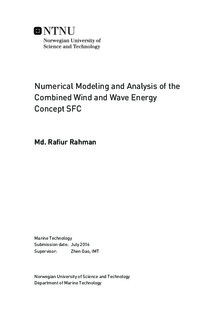Numerical Modeling and Analysis of the Combined Wind and Wave Energy Concept SFC
Master thesis
Permanent lenke
http://hdl.handle.net/11250/2403626Utgivelsesdato
2016Metadata
Vis full innførselSamlinger
- Institutt for marin teknikk [3472]
Sammendrag
This thesis work primarily aims to achieve a good understanding of the basic principle of thefrequency domain and time domain analysis methods for response analysis of combinedwind and wave energy concept SFC. SFC is a semi-submersible floating wind turbine concept with 3 wave energy converter units on each pontoon. However, this work is intendedto investigate the motion RAOs of the whole platform and internal load RAOs in the floater spontoon of the SFC at a particular position for the aligned condition. Besides, the comparison between numerical and experimental results are also performed for motion RAOs.Finally, the response analysis of the SFC in the irregular sea is performed. In time domainanalysis, the motion responses of surge, heave and pitch are carried out. Besides, the response analysis of tower base bending moment at the base of the tower is also carried out.When performing a comparative study it is important to ascertain that the numericalmodel is as much close as the physical model. But, it is important to mention that there aresome differences between the experimental model and the numerical model. In frequencydomain analysis the basic difference is the absence of mooring lines and the assumption ofthe WECs to be rigidly connected to the pontoons. So it is to be kept in mind while comparing the numerical motion RAOs of the numerical model and the experimental model. Thenumerical frequency domain analysis is performed in HydroD which uses the 1st order potential theory along with the Morison s drag for viscous forces. The differences could be thereason for discrepancies in surge and pitch motion RAOs specially. However, the physicalmodel is modelled as 1:50 using Froude s scaling law for performing the experimental analysis. But, all of the results are provided in full scale. Besides the sectional load analysis isperformed for two wave directions (00 and 1200) for investigating the dominating criteria.Finally, the fully coupled time domain numerical analysis is performed in SRA (SIMORIFLEX-Aerodyn). Here, both of the wind and wave conditions are considered. The first stepis to build the model with the import of hydrodynamic coefficients from HydroD into SIMO.This is an important step, as this may affect the accuracy of the result if there is any mistake.However, the main focus in this section is to perform the decay test of the SFC for verification.Again, there was some discrepancy specially for pitch natural period. The final task intendsto perform numerical analysis in extreme and operational environmental conditions. Thealigned condition is considered in TD analysis in terms of both wind and wave direction.
